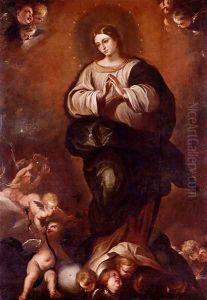Juan De Sevilla Paintings
Juan de Sevilla Romero y Escalante, commonly known as Juan de Sevilla, was a Spanish painter born in 1643 in Sevilla, Spain. He was active during the Baroque period, which is characterized by dramatic expression, rich color, and a focus on light and shadow. Sevilla's work is less well-known outside of Spain, and as such, there is limited information on his life in comparison to other artists of his era.
Sevilla trained under the guidance of Francisco de Herrera the Younger, another notable Spanish painter of the time. His style was deeply influenced by his master, and he also drew inspiration from other prominent artists like Murillo and Valdés Leal. Juan de Sevilla's art mainly consisted of religious themes, which was typical of the period, and he worked extensively on commissions for churches and religious institutions in Sevilla.
Despite his relatively modest reputation, Sevilla was a respected artist in his local community. His paintings often depicted the lives of saints and biblical narratives, executed with a keen attention to detail and an ability to convey the spiritual depth of his subjects. His work was characterized by a warm palette, and he displayed a skillful use of light to create a sense of volume and atmosphere.
Unfortunately, there is not much documentation about Sevilla's personal life or career advancements. He did not establish a significant school or following, and his art did not spread far from his native city. Nevertheless, Sevilla's contributions to the Spanish Baroque are appreciated by art historians who recognize the quality and devotion present in his surviving works.
Juan de Sevilla died in 1695 in Sevilla. His works can still be seen in various churches and museums in Spain, providing insight into the religious art and culture of 17th-century Sevilla. While he may not have achieved the fame of some of his contemporaries, his paintings remain a testament to his skill and the enduring appeal of the Baroque style.
